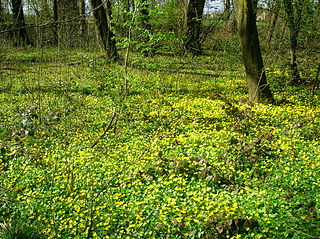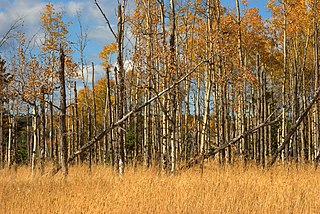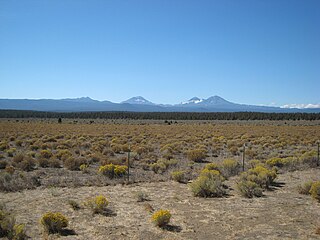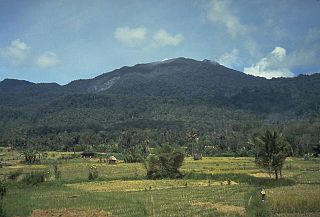
Sclerophyll is a type of vegetation that has hard leaves, short internodes and leaf orientation parallel or oblique to direct sunlight. The word comes from the Greek sklēros (hard) and phyllon (leaf).

In forestry and ecology, understory, or understorey, also known as underbrush or undergrowth, comprises plant life growing beneath the forest canopy without penetrating it to any great extent, but above the forest floor. Only a small percentage of light penetrates the canopy so understory vegetation is generally shade-tolerant. The understory typically consists of trees stunted through lack of light, other small trees with low light requirements, saplings, shrubs, vines and undergrowth. Small trees such as holly and dogwood are understory specialists.

Temperate coniferous forest is a terrestrial habitat type defined by the World Wide Fund for Nature. Temperate coniferous forests are found predominantly in areas with warm summers and cool winters, and vary in their kinds of plant life. In some, needleleaf trees dominate, while others are home primarily to broadleaf evergreen trees or a mix of both tree types. A separate habitat type, the tropical coniferous forests, occurs in more tropical climates.

Temperate broadleaf and mixed forest is a temperate climate terrestrial habitat type defined by the World Wide Fund for Nature, with broadleaf tree ecoregions, and with conifer and broadleaf tree mixed coniferous forest ecoregions.

Tropical and subtropical moist forest (TSMF), also known as tropical moist forest, is a tropical and subtropical forest habitat type defined by the World Wide Fund for Nature. The habitat type is sometimes known as jungle.

An old-growth forest – also termed primary forest, virgin forest, late seral forest or primeval forest – is a forest that has attained great age without significant disturbance and thereby exhibits unique ecological features and might be classified as a climax community. The Food and Agriculture Organization of the United Nations defines primary forests as naturally regenerated forests of native tree species where there are no clearly visible indications of human activity and the ecological processes are not significantly disturbed. More than one-third of the world’s forests are primary forests. Old-growth features include diverse tree-related structures that provide diverse wildlife habitat that increases the biodiversity of the forested ecosystem. Virgin forests are old-growth forests that have never been logged. The concept of diverse tree structure includes multi-layered canopies and canopy gaps, greatly varying tree heights and diameters, and diverse tree species and classes and sizes of woody debris.

Kelp forests are underwater areas with a high density of kelp, which covers a large part of the world's coastlines. They are recognized as one of the most productive and dynamic ecosystems on Earth. Smaller areas of anchored kelp are called kelp beds.

Aspen parkland refers to a very large area of transitional biome between prairie and boreal forest in two sections, namely the Peace River Country of northwestern Alberta crossing the border into British Columbia, and a much larger area stretching from central Alberta, all across central Saskatchewan to south central Manitoba and continuing into small parts of the US states of Minnesota and North Dakota. Aspen parkland consists of groves of aspen poplars and spruce interspersed with areas of prairie grasslands, also intersected by large stream and river valleys lined with aspen-spruce forests and dense shrubbery. This is the largest boreal-grassland transition zone in the world and is a zone of constant competition and tension as prairie and woodlands struggle to overtake each other within the parkland.

In biology, the canopy is the aboveground portion of a plant croping or crop, formed by the collection of individual plant crowns.

The black-capped fruit bat is a species of megabat in the monotypic genus Chironax.
Undergrowth usually refers to the vegetation in the lower part of a forest, which can obstruct passage through the forest. The height of undergrowth is usually considered to be 0.3 – 3 m. Undergrowth can also refer to all vegetation in a forest which is not in the canopy.

Rhododendron maximum — its common names include great laurel, great rhododendron, rosebay rhododendron, American rhododendron and big rhododendron — is a species of Rhododendron native to the Appalachians of eastern North America, from Alabama north to coastal Nova Scotia.

The Euxine-Colchic deciduous forests is a temperate broadleaf and mixed forests ecoregion located along the southern shore of the Black Sea. The ecoregion extends along the thin coastal strip from the southeastern corner of Bulgaria in the west, across the northern coast of Turkey, to Georgia in the east, where it wraps around the eastern end of the Black Sea.

Elklick Woodlands Natural Area Preserve is a 226-acre (91 ha) Natural Area Preserve located in Fairfax County, Virginia. Owned by the Fairfax County Park Authority, it is protected with a local conservation easement, and preserves a globally rare natural community known as a "northern hardpan basic oak-hickory forest". This kind of forest occurs on diabase soil with an underlay of dense plastic clay; such terrain is called "shrink-swell soil" due to extreme variations in moisture availability exhibited throughout the year. Trees which grow in such an environment are stunted, and their relatively open canopies encourage the growth of a wide variety of grasses and herbs in the understory. Such forests were once common around northern Virginia, but many have been lost due to increasing suburbanization of the area.

The Eastern Cascades Slopes and Foothills ecoregion is a Level III ecoregion designated by the United States Environmental Protection Agency (EPA) in the U.S. states of Oregon, Washington, and California. In the rain shadow of the Cascade Range, the eastern side of the mountains experiences greater temperature extremes and receives less precipitation than the west side. Open forests of ponderosa pine and some lodgepole pine distinguish this region from the Cascades ecoregion, where hemlock and fir forests are more common, and from the lower, drier ecoregions to the east, where shrubs and grasslands are predominant. The vegetation is adapted to the prevailing dry, continental climate and frequent wildfire. Volcanic cones and buttes are common in much of the region.

Browsing is a type of herbivory in which a herbivore feeds on leaves, soft shoots, or fruits of high-growing, generally woody plants such as shrubs. This is contrasted with grazing, usually associated with animals feeding on grass or other lower vegetations. Alternatively, grazers are animals eating mainly grass, and browsers are animals eating mainly non-grasses, which include both woody and herbaceous dicots. In either case, an example of this dichotomy are goats and sheep ; these two closely related ruminants utilize dissimilar food sources.

The Ecology of the North Cascades is heavily influenced by the high elevation and rain shadow effects of the mountain range. The North Cascades is a section of the Cascade Range from the South Fork of the Snoqualmie River in Washington, United States, to the confluence of the Thompson and Fraser Rivers in British Columbia, Canada, where the range is officially called the Cascade Mountains but is usually referred to as the Canadian Cascades. The North Cascades Ecoregion is a Level III ecoregion in the Commission for Environmental Cooperation's classification system.

Batang Gadis is a national park covering 1,080 km2 in North Sumatra province, Indonesia extending between 300 and 2,145 metres altitude. It is named after the Batang Gadis river that flows thorough the park. Signs of the endangered Sumatran tiger and the threatened Asian golden cat, leopard cat and clouded leopard were seen in the park. The protection of Batang Gadis as a national park is part of a plan to create the Northern Sumatra biodiversity conservation corridor, which would be connected, via a series of protected areas and forests, to Gunung Leuser National Park in the north of the island.
Scotura annulata is a moth of the family Notodontidae. It is found from Texas, south through Central America to Argentina.
Stenoplastis dyeri is a moth of the family Notodontidae. It is found on the eastern side of the Andes in Ecuador.
















